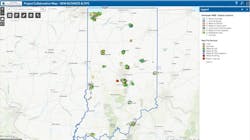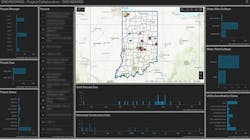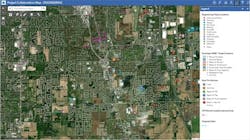Planning with GIS at Indiana-American Water
By Todd Chapman, Ryan Moore, and Randy Winston
In 2016, Indiana-American Water transitioned from using a traditional postprocessing Global Navigation Satellite System (GNSS) workflow to utilizing ArcGIS Collector and ArcGIS Online. For the first time, field data collectors could record data while all users of the platform could simultaneously view it in real time. Users could view the data in several ways, including on a map, via a dashboard, or in tabular format. Platform flexibility educated the business on the capabilities of geographic information system (GIS) technology and led end users to ask the GIS team for assistance in an increasing number of planning activities. These activities include participation in infrastructure investments and system acquisitions.
Infrastructure Investments
Indiana-American Water focuses on creating quality standards for its infrastructure investments. Infrastructure investment requests for project delivery typically come from two sources: new business and internal development. Infrastructure investments for new business are typically funded by external sources, whereas Indiana-American Water funds internal development. With hundreds of projects each year, it is critical to properly track and document all of them. Over the past two years, the Indiana-American Water GIS team has worked directly with those responsible for new business and internally developed projects to produce a series of web applications and dashboards to improve existing project tracking mechanisms.
New Business
Web application development began when the supervisor of new business, Tracy White, approached the GIS team for help in creating a GIS-based tracking mechanism for externally funded developer projects. She wanted to see the spatial context of where projects were occurring as well as their current stage of development. White said, "Prior to the development of this app, I had to rely on Excel tracking logs and emails to other personnel to determine if and when installations of water mains and private fire services were completed."
The request evolved into development of a web application based on ArcGIS Online. The application, entitled Project Collaboration for New Business, provides an interactive map that allows Indiana-American Water personnel to view new business project locations and update their statuses in real time. Each project is symbolized by its current status, accompanied by a read-only, real-time GNSS location layer. Combining project location, status, and GNSS location points provided an efficient way for Indiana-American Water to track the progress of all new business projects.
"The Project Collaboration app has improved my efficiency in tracking over 100 open projects at any given time. Now the information is also live and up-to-date in the map, improving our customer service response times and, therefore, customer satisfaction," said Tracy White, supervisor of new business.
Engineering and Planning
After the deployment of the Project Collaboration for New Business web application, the GIS and engineering teams realized that Indiana-American Water could benefit from applying the same project concept to support internal development. This includes engineering project delivery and planning projects, which can be categorized into multiple types such as pipe relocation, pipe replacement, and comprehensive planning study (CPS).
At first, the GIS, engineering, and planning teams collaborated to determine which project types had the biggest immediate use for an improved tracking mechanism. Feedback revealed a need for a centralized location to store pertinent data for pipe relocation and pipe replacement projects. Because these project types were tracked similarly, the GIS team—working with engineering staff — created a list of project statuses that aligned with them.
The next step was to visualize project locations by project status and to provide an easy way to update the location and attribute information for each project. This was accomplished by deploying another web application, Project Collaboration for Engineering, which functioned and looked like the Project Collaboration for New Business app. This time, instead of being allowed to edit new business projects, end users could add and modify only engineering projects. Additionally, the symbology was based on project stages for engineering instead of those relevant for new business. Finally, view-only layers showing new business projects, new fire service locations, and real-time GNSS point locations were added to provide a holistic view of projects occurring in all the company's operations across Indiana. As the new business and operations staff updated their projects, engineering personnel could view their status without changing maps.
In addition to the web application, the GIS team wanted to give project managers the ability to view their workload and monitor projects with upcoming due dates. For this, an engineering dashboard was created, allowing managers to view their projects by title, type, and status as well as utility coordination status. Using the dashboard—combined with the Project Collaboration web applications — engineers at Indiana-American Water now have the tools available to fully track and monitor all projects in real time, with minimal support from the GIS team.
To help visualize future projects, the GIS team is currently working with the engineering planning staff to enhance the Project Collaboration for Engineering web application. The app will support CPS projects, which are recommended system capital investments that will improve performance, safety, efficiency, capacity, reliability, service, or regulatory compliance as well as water quality. The GIS team is providing a new layer for the planning team to begin entering future project locations. When the layer is fully developed, information about these planned projects will be more efficiently available for internal engineering personnel as they begin to work on them. The efficient spatial accessibility of the information will also help internal staff visualize relationships between planned and emerging projects in a way that could lead to enhanced solution development.
System Acquisitions
Indiana-American Water's core business is to provide safe, clean, reliable, and affordable drinking water to the company's customers. This includes the customers added through utility acquisitions. Indiana-American Water director of governmental affairs Justin Schneider said, "The use of GIS allows us to visualize opportunities to implement the policy of the State of Indiana to promote regionalization and collaboration between utilities. It is an important tool to identify areas without infrastructure, support interconnections with other communities, and help facilitate partnerships with communities as their water and wastewater utility to support their constituents and needs for economic development."
Esri's GIS platform empowers the Indiana-American Water business development team to spatially visualize and evaluate datasets that were previously available only in tabular format. The team can also utilize the Esri platform to validate acquired assets.
"The use of GIS allows us to visualize opportunities to implement the policy of the State of Indiana to promote regionalization and collaboration between utilities. It is an important tool to identify areas without infrastructure, support interconnections with other communities, and help facilitate partnerships with communities as their water and wastewater utility to support their constituents and needs for economic development," said Justin Schneider, director of governmental affairs.
When a water or wastewater system joins Indiana-American Water through acquisition, the GIS team is asked to assist in validating asset locations and details relating to the purchase. For example, current records may estimate that an acquired system has 315 water valves and 100 fire hydrants. The GIS team uses ArcGIS Online and ArcGIS Collector to validate the number of newly acquired assets and the attributes associated with them (valve size, hydrant type, etc.). In addition to validation, this process assists in building the system's initial GIS water network.
Following wastewater acquisitions, the GIS team uses ArcGIS Online and ArcGIS Collector to validate manhole locations and collect essential details, such as pipe size and flow direction, to construct the system's initial GIS sewer network. A z-value-enabled hosted feature dataset in ArcGIS Online allows the team to accurately capture rim elevation, while the use of a laser distance meter lets staff measure for and calculate invert depth. The ease of use and efficiency in capturing real-time z-value-enabled spatial data allow Indiana-American Water to keep the initial manhole data validation and collection in-house.
Conclusion
As a result of centralizing multiple pieces of real-time data, the Indiana American Water GIS team is providing the business with more tools to efficiently plan and manage internal system capital improvements and externally funded new business developer projects. Web GIS also equips business development with tools to efficiently visualize essential datasets in utility acquisitions. New business, engineering, and planning staff now have the means to more efficiently visualize and update planned and active projects to ensure that important data is captured and monitored in a consistent and accurate way. The addition of real-time GNSS datasets empowers project managers to actively monitor field progress, ensuring that all new assets are recorded appropriately. As a result of collaborating with the new business, engineering, and other functional teams, the Indiana-American Water GIS team has been able to provide holistic and integrated solutions that greatly assist personnel across functions to achieve their goals and ultimately add value for the company and its customers.
"The use of GIS allows us to visualize opportunities to implement the policy of the State of Indiana to promote regionalization and collaboration between utilities. It is an important tool to identify areas without infrastructure, support interconnections with other communities, and help facilitate partnerships with communities as their water and wastewater utility to support their constituents and needs for economic development," Schneider said.


